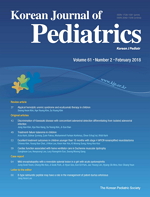Article Contents
| Korean J Pediatr > Volume 61(2); 2018 |
|
Abstract
Purpose
Methods
Results
Notes
Conflicts of interest:
No potential conflict of interest relevant to this article was reported.
References
Table 1
Demographic characteristics of patients with Duchenne muscular dystrophy
Table 2
Comparison of pulmonary function measurements
| Measurement | Nonventilator (n=30) | Home-ventilator (n=24) | P value |
|---|---|---|---|
| Sitting FVC (mL) | 1,455±603.12 | 1,038±620.41 | 0.024 |
| PCF (mL) | 231.57±98.86 | 195.56±76.02 | 0.196 |
Table 3
Comparison of echocardiographic measurements
Values are presented as mean±standard deviation.
LV, left ventricle; EF, ejection fraction; FS, fractional shortening; IVSTd, interventricular septal thickness, diastole; IVSTs, interventricular septal thickness, systole; LVIDd, left ventricle internal diameter, diastole; LVIDs, left ventricle internal diameter, systole; PWTd, posterior wall thickness, diastole; PWTs, posterior wall thickness, systole; E, peak early mitral inflow velocity; A, peak late mitral inflow velocity; E′, peak early diastolic septal annulus velocity; A′, peak late diastolic septal annulus velocity; S′, peak systolic septal annulus velocity.
Table 4
Multiple linear regression analysis of echocardiographic measurements
LV, left ventricle; EF, ejection fraction; FS, fractional shortening; IVSTd, interventricular septal thickness, diastole; IVSTs, interventricular septal thickness, systole; LVIDd, left ventricle internal diameter, diastole; LVIDs, left ventricle internal diameter, systole; PWTd, posterior wall thickness, diastole; PWTs, posterior wall thickness, systole; E, peak early mitral inflow velocity; A, peak late mitral inflow velocity; E′, peak early diastolic septal annulus velocity; A′, peak late diastolic septal annulus velocity; S′, peak systolic septal annulus velocity.
*Beta (standard error) means comparing the strength of the effect of independent variables between the 2 groups (nonventilator group, n=0; home ventilator group, n=1).




 PDF Links
PDF Links PubReader
PubReader ePub Link
ePub Link PubMed
PubMed Download Citation
Download Citation


